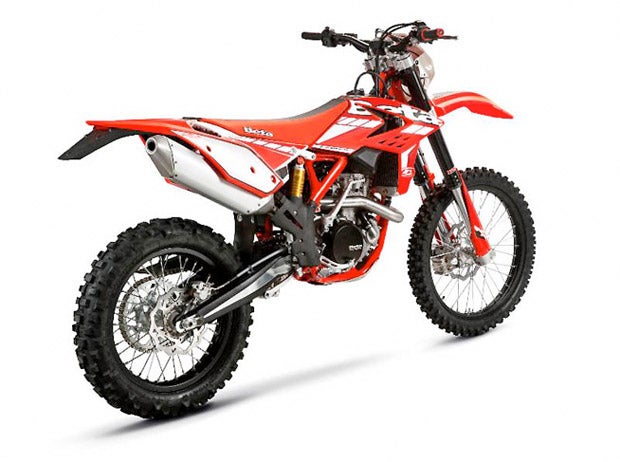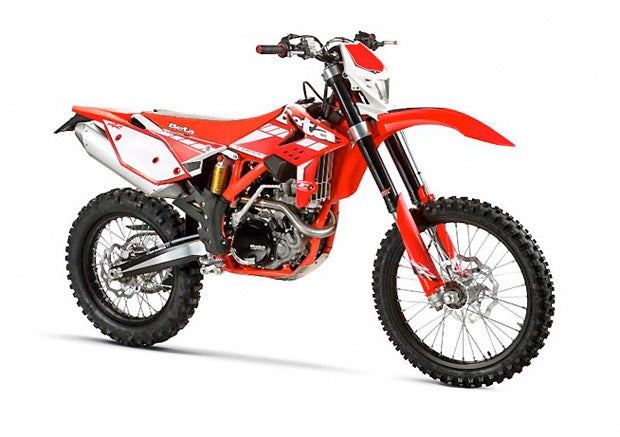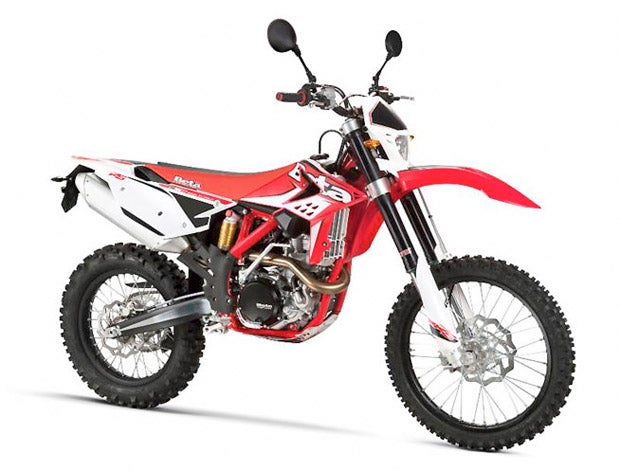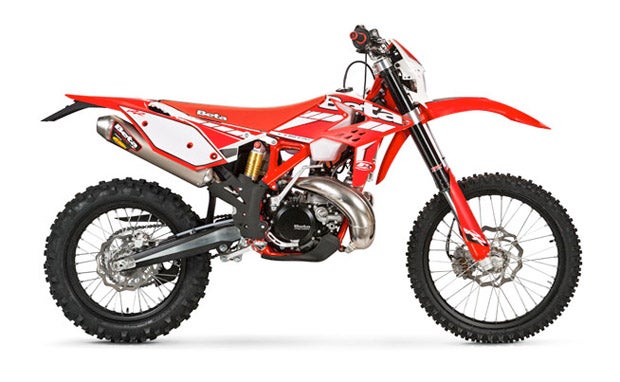
Italian dirt bike manufacturer Beta has made a strong push in the U.S. market in recent years, and the company’s off-road and dual-sport bikes have been gaining popularity after being lauded by enthusiasts and journalists for their performance and quality in design and craftsmanship. Beta recently released information on its 2015 line, with major upgrades made to its four-stroke engine that incorporates electronic fuel injection, and it also made improvements to its two-stroke models as well.
2015 Beta RR Four-Strokes
Engine
The primary goals with Beta’s RR line of four-stroke off-road competition bikes included making the bike lighter and easier to ride while maintaining its competition capabilities. To those ends, the engine’s center cases and internal components have been redesigned to make them more compact, shave weight and reduce the rotating mass, all of which positively influence handling. The displacement of the engines has been downsized as well, although Beta claims that power and torque figures remain unchanged thanks to new camshaft profiles and new exhaust systems on the four-strokes, and the new engines provide an even better distribution of torque than the old ones did.
A huge part of that change has to come from the RR’s new fueling system, which incorporates an all-new electronic fuel injection system designed in conjunction with Synerject, a US company based in Virginia. The system features a 42 mm throttle body that utilizes a stepper motor to ensure an accurate minimum rotation speed, reducing engine braking considerably.
With regard to the actual displacement of the engines, Beta says that its engineering team has come up with the “the perfect displacements” for the new engine designs. For 2015, the RR is available in four sizes: The 350 RR, the 390 RR (down from 400), the 430 RR (down from 450) and the 480 RR (down from 498). The total weight has been reduced by 1kg (2.2 lbs.) on the 430 and 480 engines, compared with the previous 2014 models, and by as much as 1.5kg (3.3 lbs.) for the 350 and the 390.
To achieve this, the engine main cases have been completely redesigned, with new, lighter die-castings that house a new oil pump drive system designed to be simpler and more efficient thanks to the elimination of a drive gear. The crankcase chamber has been redesigned to minimize pumping losses, and the new design features stiffening ribs that maintain case rigidity while allowing for the more compact design. The clutch and flywheel covers have also been modified to reduce weight and increase rigidity.
As part of the effort to decrease rotating weight, Beta four-strokes feature a new crankshaft with lighter flywheels that also reduces inertia, which helps the bikes rev more quickly and also makes them more agile handling by reducing gyroscopic effect. A new-design connecting rod is shorter and lighter to further reduce rotating mass. The rod is mated to a lighter and stronger piston that uses a Formula 1-car style design called “box-in-box,” which is claimed to reduce vibration and increase performance. The piston pin is coated with a Diamond-Like-Carbon (DLC) treatment to minimize friction and wear.
The RR’s new camshaft profiles were developed to boost low-speed performance for better overall power delivery. The cams reside in a new, more compact cylinder head that has been completely redesigned both in terms of the ports and combustion chamber shape to meet the requirements of the new engine sizes. For example, the intake tract has been redesigned to improve fuel atomization at low speeds. The cylinder itself also features a new design for the water jackets to increase cooling system efficiency.
Other changes to the engine include an improved starter motor that is more powerful and lighter than the previous motor and a redesigned balancer shaft that is also lighter than the previous version.
The 2015 RR exhaust system uses a redesigned muffler with new internal passages and a larger diameter manifold connection intended to provide optimum power while retaining its quiet exhaust note. USA models will be feature a spark arrestor as standard equipment.

Chassis & Suspension
The Beta RR’s beautifully sculpted chrome moly chassis and aluminum swingarm are retained for 2015, but its Sachs suspension has been further developed in collaboration between Beta and Sach’s engineers—a welcome effort in our books. Up front, the Beta’s Sachs 48mm USD fork features numerous changes, including a new compression piston design with what Beta calls “three slot” geometry intended to improve the oil flow and make it more direct for a more progressive feel in large bumps. Attention was also paid to improve the fork’s initial smoothness as well. A spring-support release system has been incorporated to eliminate rotational friction, and the sleeves and bushings has been altered to tighten the tolerance between the slider and the bushings. The spring profile has also been redesigned for a better fit inside the fork, and the fork’s valving has also been changed.
Out back, the Sachs piggyback reservoir shock receives a new internal piston with oil passages that have been redesigned to improve flow and run cooler to resist fading. The end result should be a more consistent-feeling suspension that is easier to dial-in for riding conditions.
Ergonomics & Styling
Beta made only a couple additional changes to the RR models for 2015, but in our opinion, one of them may prove to be extremely positive. Recall that in our 2014 Beta vs. KTM dual-sport shootout, we complained that the 520 RS had an extremely hard seat. For 2015, all Beta seats will feature new softer foam under their slip-resistant seat covers. Yay! Naturally, the 2015 RRs also receive a new graphic treatment that, Beta says, streamlines the look of the bikes and adds character while maintaining the classic Beta colors.

2015 Beta RS Four-Strokes
Like the RR off-road machines, Beta’s RS dual-sport models are also offered in three new displacement sizes for 2015. The RS models, which share all of the engine updates as the new RR models, including the electronic fuel-injection will be available in 390cc, 430cc, and 500cc sizes. The RS models are basically RRs with license plates, featuring the same engine, frame, and suspension (including linkage) package as the RR models but with the necessary equipment to make them DOT and EPA legal.
2015-Beta-Trail-Tech-voyager-GPSThe awesome Voyager GPS/speedometer units still come standard on all RS models. The unit features a GPS system, speedometer, tachometer, engine coolant temperature, compass, outside temperature, trip meter, maps and an external SD card that allows the user to uploading and download gpx files. All RS models are fitted with cooling fan kits to help reduce engine temperatures in low-speed conditions. The dual-sport machines ride on DOT-legal Michelin Enduro tires with a tread design described as 90/10 percent off-road/road.
2015 Beta RR Two-Strokes
Beta-2-stroke-engineBeta’s 2015 RR Enduro two-stroke range has also received changes for 2015, with the 250 RR featuring technical improvements while the 300RR has received special parts from the 2014 Race Edition factory racebike. The objective in both cases was improve power delivery from bottom to top by making it smoother.
The 250 RR’s exhaust valve adjustment system has been modified by increasing the number of adjustment springs from one to two, making it the same as the 300cc engine. Beta says that the dual-spring arrangement significantly improves engine output by optimizing the opening of the exhaust valve at every stage of operation. The 250 RR also receives a new muffler with a smaller inner diameter than the 300 RR. The smaller size helps to improve the 250RR’s throttle response and increases peak revs.
The 300 RR’s engine is lifted directly from the 2014 RR Race Edition, and it includes a new cylinder, combustion chamber and CDI. Beta says that the engine’s narrower exhaust port width and better-sealed power valve provides improved throttle response and linear power without interfering in any way with the maximum power and torque figures. A digital electronic control unit is designed to optimize engine output throughout the rev range to increase ride-ability.

Beta’s two-strokes share the same chassis and suspension as its four-strokes, and for 2015 the two-strokes also receive the redesigned Sachs USD 48mm fork and piggyback reservoir rear shock. Like the four-strokes, the padding in the two-stroke seats has been redesigned with softer foam. The 2015 RR’s also get a new look with restyled graphics in the classic Beta colors.
BYOB
By now you should know that this does not mean Bring Your Own Beer! Beta’s exclusive Build Your Own Beta program is back for 2015. The BYOB program allows buyers to custom build their new Beta online, drawing from host of factory accessory parts. The custom machine is then shipped to the Beta dealer of their choice about 30 days after the order has been submitted.
Beta had a strong year in 2014, and judging by the initial presentation of its new models, 2015 could be a banner year. For more information on the 2015 Beta models and the BYOB program, visit www.betausa.com.


 Your Privacy Choices
Your Privacy Choices